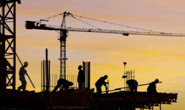Analysis

September 18, 2020
Construction Employment Drops During Pandemic
Written by Sandy Williams
The year 2020 started out strong for the construction industry, but the latest annual employment figures show the impact of the pandemic. Canceled or postponed construction projects were reflected in new government data on construction employment analyzed by the Associated General Contractors of America.
Construction jobs fell in 39 states between August 2019 and August 2020, while 31 states and the District of Columbia added jobs between July and August, said AGC.
“The ongoing pandemic is prompting ever more private owners, developers and public agencies to delay and cancel projects,” said AGC Chief Economist Ken Simonson. “The share of contractors that reported postponed or canceled projects nearly doubled, while the share who reported winning new or expanded work dropped nearly in half.”
AGC broke down the gains and losses in employment as follows:
California lost the most construction jobs (-52,000, -5.8 percent) between August 2019 and August 2020, followed by New York (-46,000, -11.3 percent), Texas (-39,300 jobs, -5.0 percent), Massachusetts (-20,200 jobs, -12.4 percent) and Illinois (-17,200 jobs, -7.5 percent). Vermont lost the highest percent of construction jobs for the year (-29.6 percent, -4,500 jobs), followed by Massachusetts, Iowa (-11.8 percent, -9,300 jobs), Louisiana (-11.4 percent, -15,700 jobs) and New York.
Ten states and the District of Columbia added construction jobs between August 2019 and August 2020, while construction employment was unchanged in Montana. Utah added the most new construction jobs (8,800 jobs, 8.0 percent), followed by Virginia (4,400 jobs, 2.2 percent), Maryland (3,800 jobs, 2.3 percent), Indiana (3,100 jobs, 2.1 percent) and Missouri (2,700 jobs, 2.1 percent). South Dakota added the highest percent (10.9 percent, 2,600 jobs), followed by Utah, Idaho (2.4 percent, 1,300 jobs); Maryland and Virginia.
California added the most new construction jobs (6,700 jobs, 0.8 percent) between July and August, followed by New York (5,200 jobs, 1.5 percent), Pennsylvania (4,100 jobs, 1.7 percent), Texas (3,300 jobs, 0.4 percent) and Oregon (3,200 jobs, 3.1 percent). New Mexico added the highest percentage (6.7 percent, 3,100) of jobs for the month, followed by Mississippi (3.4 percent, 1,400 jobs), Oregon and Kentucky (2.0 percent, 1,600 jobs).
Nineteen states lost construction jobs for the month with Nevada losing the most (-2,600 jobs, -2.8 percent). Other states losing a high number of construction jobs for the month include Florida (-2,200 jobs, -0.4 percent); Nebraska (-1,800 jobs, -3.3 percent) and North Carolina (-1,800 jobs, -0.8 percent). Hawaii lost the highest percentage (-3.5 percent, -1,300 jobs) of construction jobs for the month, followed by West Virginia (-3.3 percent, -1,100 jobs); Nebraska and Nevada.







